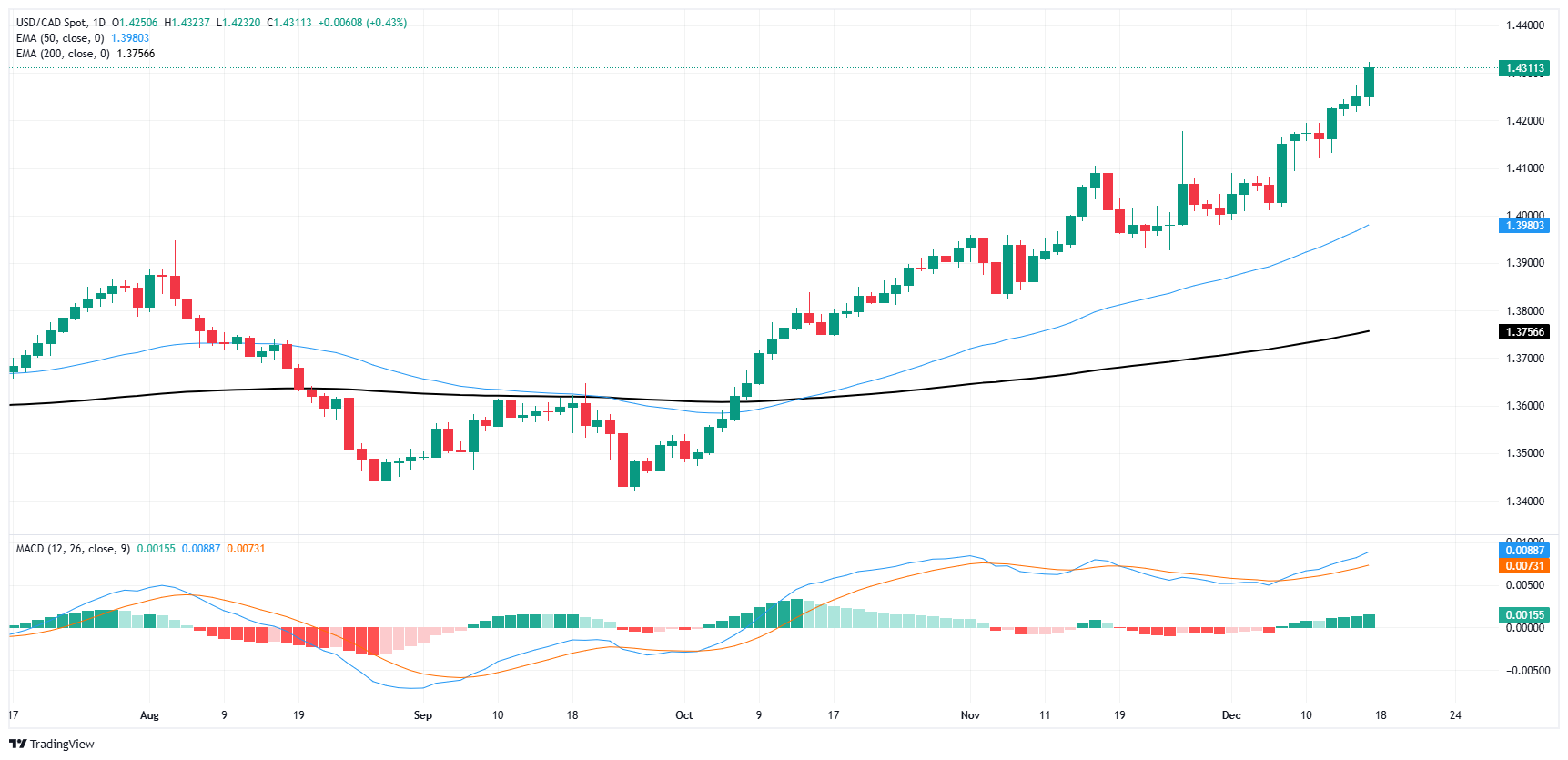- The Canadian Dollar lost another 0.4% against the Greenback on Tuesday.
- Canada saw a sharper than expected headline CPI contraction.
- Underlying drivers of Canadian inflation raise warning signs for consumer spending.
The Canadian Dollar (CAD) fell to a new multi-year low on Tuesday, losing four tenths of a percent against the greenback and pushing USD/CAD to its highest bids in almost five years, sending the pair above 1.4300 for the first time since March 2020. Canada’s annualized Consumer Price Index (CPI) figures disappointed markets, delivering a confusing picture of Canadian price growth on both sides of the equation.
Despite the Canadian headline CPI softening below 2% on an annual basis, monthly inflation figures appear to remain stagnant. Core CPI inflation also remains persistent, trending north of 2.7% year-on-year, although the Bank of Canada’s (BoC) own measure of core CPI continues to decline.
Daily Market Summary: Canadian Dollar Falls Further After CPI Misses Expectations
- Canadian headline CPI inflation stood at 1.9% year-on-year, below the expected 2.0%.
- The BoC’s internal core CPI metric grew 1.6% year-on-year, down from 1.7% previously.
- The overall pullback in Canadian headline CPI figures will help bolster expectations of another BoC rate cut in January, despite recent warnings from BoC Governor Tiff Macklem that the pace of BoC rate cuts It will be “more gradual” from now on.
- Core inflation remains persistent despite declines in headline figures; While the BoC expects core inflation to average 2.3% in the fourth quarter, it is currently close to 2.7%.
- Mortgage interest costs softened in November, helping to lower CPI metrics, although underlying rental prices accelerated another 7.7% in the same period.
- Even though Canadians welcomed discounts on electronics and guided travel costs around Black Friday, another 2.6% annualized increase in grocery costs continues to hit pocketbooks as Canadians struggle to replace food with televisions.
Canadian Dollar Price Forecast
The Canadian Dollar has lost more than 2.2% against the US Dollar in December and is on track to finish lower against the Dollar for the fourth consecutive month. As the CAD continues to deflate against the USD, USD/CAD prices have risen back above the 1.4300 level, an increase of almost 7% from September bid lows near 1.3420.
USD/CAD has been moving steadily north in a one-sided medium-term trend, and the 50-day EMA has struggled to keep up with the price action as the key moving average rises to 1.3400 . As Dollar buyers continue to pound the CAD, USD/CAD bids are heading to highs not seen since the height of the COVID pandemic above 1.4600.
USD/CAD daily chart
Canadian Dollar FAQs
The key factors that determine the price of the Canadian Dollar (CAD) are the level of interest rates set by the Bank of Canada (BoC), the price of oil, Canada’s main export product, the health of its economy, inflation and the trade balance, which is the difference between the value of Canadian exports and its imports. Other factors are market confidence, that is, whether investors bet on riskier assets (risk-on) or look for safe assets (risk-off), with the risk-on being positive for the CAD. As its largest trading partner, the health of the US economy is also a key factor influencing the Canadian dollar.
The Bank of Canada (BoC) exerts significant influence over the Canadian Dollar by setting the level of interest rates that banks can lend to each other. This influences the level of interest rates for everyone. The BoC’s main objective is to keep inflation between 1% and 3% by adjusting interest rates up or down. Relatively high interest rates are usually positive for the CAD. The Bank of Canada can also use quantitative easing and tightening to influence credit conditions, with the former being negative for the CAD and the latter being positive for the CAD.
The price of oil is a key factor influencing the value of the Canadian Dollar. Oil is Canada’s largest export, so the price of oil tends to have an immediate impact on the value of the CAD. Generally, if the price of oil rises, the CAD also rises, as aggregate demand for the currency increases. The opposite occurs if the price of oil falls. Higher oil prices also tend to lead to a higher probability of a positive trade balance, which also supports the CAD.
Although inflation has traditionally always been considered a negative factor for a currency, as it reduces the value of money, the opposite has actually happened in modern times, with the relaxation of cross-border capital controls. Higher inflation often leads central banks to raise interest rates, attracting more capital inflows from global investors looking for a lucrative place to store their money. This increases the demand for the local currency, which in the case of Canada is the Canadian Dollar.
The published macroeconomic data measures the health of the economy and may have an impact on the Canadian dollar. Indicators such as GDP, manufacturing and services PMIs, employment and consumer confidence surveys can influence the direction of the CAD. A strong economy is good for the Canadian dollar. Not only does it attract more foreign investment, but it may encourage the Bank of Canada to raise interest rates, resulting in a stronger currency. However, if economic data is weak, the CAD is likely to fall.
Source: Fx Street
I am Joshua Winder, a senior-level journalist and editor at World Stock Market. I specialize in covering news related to the stock market and economic trends. With more than 8 years of experience in this field, I have become an expert in financial reporting.







